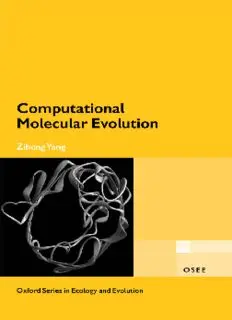
Computational Molecular Evolution PDF
Preview Computational Molecular Evolution
Computational Molecular Evolution YANG-4: “FM” — 2006/9/1 — 14:17 — PAGE i — #1 OxfordSeriesinEcologyandEvolution EditedbyPaulH.HarveyandRobertM.May TheComparativeMethodinEvolutionaryBiology PaulH.HarveyandMarkD.Pagel TheCauseofMolecularEvolution JohnH.Gillespie DunnockBehaviourandSocialEvolution N.B.Davies NaturalSelection:Domains,Levels,andChallenges GeorgeC.Williams BehaviourandSocialEvolutionofWasps:TheCommunalAggregationHypothesis YosiakiItô LifeHistoryInvariants:SomeExplorationsofSymmetryinEvolutionaryEcology EricL.Charnov QuantitativeEcologyandtheBrownTrout J.M.Elliott SexualSelectionandtheBarnSwallow AndersPapeMøller EcologyandEvolutioninAnoxicWorlds TomFenchelandBlandJ.Finlay AnolisLizardsoftheCaribbean:Ecology,EvolutionandPlateTectonics JonathanRoughgarden FromIndividualBehaviourtoPopulationEcology WilliamJ.Sutherland EvolutionofSocialInsectColonies:SexAllocationandKinSelection RossH.CrozierandPekkaPamilo BiologicalInvasions:TheoryandPractice NanakoShigesadaandKohkichiKawasaki CooperationAmongAnimals:AnEvolutionaryPerspective LeeAlanDugatkin NaturalHybridizationandEvolution MichaelL.Arnold EvolutionofSiblingRivalry DouglasMockandGeoffreyParker Asymmetry,DevelopmentalStability,andEvolution AndersPapeMøllerandJohnP.Swaddle MetapopulationEcology IlkkaHanski DynamicStateVariableModelsinEcology:MethodsandApplications ColinW.ClarkandMarcMangel TheOrigin,Expansion,andDemiseofPlantSpecies DonaldA.Levin TheSpatialandTemporalDynamicsofHost-ParasitoidInteractions MichaelP.Hassell TheEcologyofAdaptiveRadiation DolphSchluter ParasitesandtheBehaviorofAnimals JaniceMoore EvolutionaryEcologyofBirds PeterBennettandIanOwens TheRoleofChromosomalChangeinPlantEvolution DonaldA.Levin LivinginGroups JensKrauseandGraemeRuxton StochasticPopulationDynamicsinEcologyandconservation RussellLande,SteinerEngenandBernt-ErikSœther ThestructureandDynamicsofGeographicRanges KevinJ.Gaston AnimalSignals JohnMaynardSmithandDavidHarper EvolutionaryEcology:TheTrinidadianGuppy AnneE.Magurran InfectiousDiseaseandPrimateSocioecology CharlesL.NunnandSoniaM.Altizer ComputationalMolecularEvolution ZihengYang YANG-4: “FM” — 2006/9/1 — 14:17 — PAGE ii — #2 Computational Molecular Evolution ZIHENGYANG University College London,UK 1 YANG-4: “FM” — 2006/9/1 — 14:17 — PAGE iii — #3 3 GreatClarendonStreet,OxfordOX26DP OxfordUniversityPressisadepartmentoftheUniversityofOxford. ItfurtherstheUniversity’sobjectiveofexcellenceinresearch,scholarship, andeducationbypublishingworldwidein Oxford NewYork Auckland CapeTown DaresSalaam HongKong Karachi KualaLumpur Madrid Melbourne MexicoCity Nairobi NewDelhi Shanghai Taipei Toronto Withofficesin Argentina Austria Brazil Chile CzechRepublic France Greece Guatemala Hungary Italy Japan Poland Portugal Singapore SouthKorea Switzerland Thailand Turkey Ukraine Vietnam OxfordisaregisteredtrademarkofOxfordUniversityPress intheUKandincertainothercountries PublishedintheUnitedStates byOxfordUniversityPressInc.,NewYork ©OxfordUniversityPress2006 Themoralrightsoftheauthorhavebeenasserted DatabaserightOxfordUniversityPress(maker) Firstpublished2006 Allrightsreserved.Nopartofthispublicationmaybereproduced, storedinaretrievalsystem,ortransmitted,inanyformorbyanymeans, withoutthepriorpermissioninwritingofOxfordUniversityPress, orasexpresslypermittedbylaw,orundertermsagreedwiththeappropriate reprographicsrightsorganization.Enquiriesconcerningreproduction outsidethescopeoftheaboveshouldbesenttotheRightsDepartment, OxfordUniversityPress,attheaddressabove Youmustnotcirculatethisbookinanyotherbindingorcover andyoumustimposethesameconditiononanyacquirer BritishLibraryCataloguinginPublicationData Dataavailable LibraryofCongressCataloginginPublicationData Dataavailable TypesetbyNewgenImagingSystems(P)Ltd.,Chennai,India PrintedinGreatBritain onacid-freepaperby BiddlesLtd.,King’sLynn ISBN 0–19–856699–9 978–0–19–856699–1 ISBN 0–19–856702–2(Pbk.) 978–0–19–856702–8(Pbk.) 10 9 8 7 6 5 4 3 2 1 YANG-4: “FM” — 2006/9/1 — 14:17 — PAGE iv — #4 Tomyparents YANG-4: “FM” — 2006/9/1 — 14:17 — PAGE v — #5 This page intentionally left blank Preface Studiesofevolutionatthemolecularlevelaimtoaddresstwomajorquestions:recon- struction of the evolutionary relationships among species and investigation of the forces and mechanisms of the evolutionary process. The first is the realm of sys- tematics,andistraditionallystudiedusingmorphologicalcharactersandfossils.The great utility and easy availability of molecular data have made molecules the most commontypeofdatausedforphylogenyreconstructioninmostspeciesgroups.The second question concerning the mechanisms of molecular evolution is studied by estimatingtheratesofnucleotideandaminoacidsubstitutions,andbytestingmodels ofmutationandselectionusingsequencedata. Both areas of research have experienced phenomenal growth in the past few decades,duetotheexplosiveaccumulationofgeneticsequencedata,improvedcom- puter hardware and software, and development of sophisticated statistical methods suitableforaddressinginterestingbiologicalquestions.Byallindications,thisgrowth isboundtocontinue,especiallyonthefrontofdatageneration.Phylogeneticanalysis hasenteredthegenomicage,withlargedatasetsconsistingofhundredsofspeciesor sequencesanalysedroutinely.Thedebateofmorphologyversusmoleculesislargely over;thevaluesofbothkindsofdataarewellappreciatedbymostresearchers.The philosophicaldebateconcerningparsimonyversuslikelihoodisongoingbutappeared tobecomelessacrimonious.Muchexcitingprogresshasbeenmadetodevelopand implementpowerfulstatisticalmethodsandmodels,whicharenowusedroutinelyin analysisofrealdatasets. Thetimeappearsripetosummarizethemethodologicaladvancementsinthefield, andthisbookissuchanattempt.Imakenoefforttobecomprehensiveinthecoverage. There is hardly such a need now, thanks to recent publication of Joseph Felsen- stein’s(2004)treatise,whichhasdiscussedalmosteverythingrelevanttophylogenies. InsteadItaketheviewthatmolecularevolutionaryanalysis,includingreconstruction of phylogenies and inference of the evolutionary process, is a problem of statisti- cal inference (Cavalli-Sforza and Edwards 1967). Thus well-established statistical methods such as likelihood and Bayesian are described as standard. Heuristic and approximate methods are discussed from such a viewpoint and are often used to introducethecentralconcepts,becauseoftheirsimplicityandintuitiveappeal,before morerigorousmethodsaredescribed.Iincludesomediscussionsofimplementation issuessothatthebookcanserveasareferenceforresearchersdevelopingmethods ofdataanalysis. YANG-4: “FM” — 2006/9/1 — 14:17 — PAGE vii — #7 viii • Preface Thebookiswrittenforupper-levelundergraduatestudents,researchstudents,and researchersinevolutionarybiology,molecularsystematics,andpopulationgenetics. Itishopedthatbiologistswhohaveusedsoftwareprogramstoanalysetheirowndata willfindthebookparticularlyusefulinhelpingthemunderstandtheworkingsofthe methods.Thebookemphasizesessentialconceptsbutincludesdetailedmathematical derivations,soitcanbereadbystatisticians,mathematicians,andcomputerscientists, whowouldliketoworkinthisexcitingareaofcomputationalbiology. Thebookassumesanelementaryknowledgeofgenetics,asprovided,forexample, byChapter1ofGraurandLi(2000).Knowledgeofbasicstatisticsorbiostatisticsis assumed,andcalculusandlinearalgebraisneededinsomepartsofthebook.Likeli- hoodandBayesianstatisticsareintroducedusingsimpleexamplesandthenusedin moresophisticatedanalyses.Readerswhowouldlikeasystematicandcomprehen- sive treatment of these methods should consult many of the excellent textbooks in probabilitytheoryandmathematicalstatistics,forexampleDeGrootandSchervish (2002)attheelementarylevel,andDavison(2003),Stuartetal.(1999),andLeonard andHsu(1999)atmoreadvancedlevels. The book is organized as follows. Part I consists of two chapters and intro- ducesMarkov-processmodelsofsequenceevolution.Chapter1discussesmodelsof nucleotidesubstitutionandcalculationofthedistancebetweenapairofsequences. Thisisperhapsthesimplestphylogeneticanalysis,andItaketheopportunitytointro- duce the theory of Markov chains and the maximum likelihood method, which are usedextensivelylaterinthebook.Asaresult,thischapterisprobablymostchalleng- ing for the biologist reader. Chapter 2 describes Markov-process models of amino acidandcodonsubstitutionandtheiruseincalculationofthedistancebetweentwo protein sequences and in estimation of synonymous and nonsynonymous substitu- tion rates between two protein-coding DNA sequences. Part II deals with methods ofphylogenyreconstruction.Parsimonyanddistancemethodsarediscussedbriefly (Chapter3),whilelikelihoodandBayesianmethodsarecoveredindepth(Chapters4 and5).Chapter5isanexpandedversionofthechapterinMathematicsinPhylogeny andEvolutioneditedbyOlivierGascuel(OxfordUniversityPress,2005).Chapter6 providesareviewofstudiesthatcomparedifferentphylogenyreconstructionmeth- odsandcoverstestingoftrees.PartIIIdiscussesafewapplicationsofphylogenetic methods to study the evolutionary process, such as testing the molecular clock and usingtheclocktoestimatespeciesdivergencetimes(Chapter7),andapplicationsof models of codon substitution to detect natural selection affecting protein evolution (Chapter 8). Chapter 9 discusses basic techniques of computer simulation. Chapter 10includesadiscussionofcurrentchallengesandfutureperspectivesofthefield.A briefreviewofmajorphylogeneticssoftwarepackagesareincludedinAppendixC. Sectionsmarkedwithanasterisk*aretechnicalandmaybeskipped. Example data sets used in the book and small C programs that implement algorithms discussed in the book are posted at the web site for the book: http://abacus.gene.ucl.ac.uk/CME/. It will also include a list of errors discovered since publication of the book. Please report errors you discover to the author at [email protected]. YANG-4: “FM” — 2006/9/1 — 14:17 — PAGE viii — #8 Preface • ix Iamgratefultoanumberofcolleagueswhoreadearlierversionsofchaptersofthis bookandprovidedconstructivecommentsandcriticisms:HiroshiAkashi(chapters 2 and 8), Adam Eyre-Walker (chapter 2), Jim Mallet (chapters 4 and 5), Konrad Scheffler(chapters1,5,and8),ElliottSober(chapter6),MikeSteel(chapter6),Jeff Thorne(chapter6),SimonWhelan(chapter1),andAnneYoder(chapter6).Special thanksgotoKarenCranston,LigiaMateiuandFengrongRen,whoreadthewhole bookandprovidedmanydetailedsuggestions.JessicaVamathevanandRichardEmes werevictimsofmyexperimentswhenItestedsomedifficultpassages.Needlessto say,allerrorsthatremainaremine.ThanksarealsoduetoIanShermanandStefanie GehrigatOxfordUniversityPressforinitiatingthisprojectandforvaluablesupport andpatiencethroughoutit. ZihengYang London March2006 YANG-4: “FM” — 2006/9/1 — 14:17 — PAGE ix — #9
